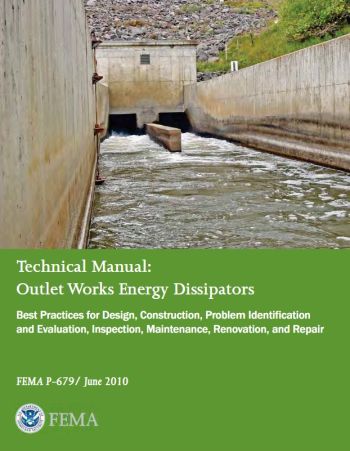Technical Manual: Outlet Works Energy Dissipators (FEMA P-679)
Federal Emergency Management Agency, 2010

Water emerging from an outlet works conduit typically requires dissipation of excess kinetic energy to prevent downstream channel erosion. This flow often discharges at a high velocity and must be directed away from the toe of the dam. An energy dissipater is used to retard the fast moving water by creating turbulence and developing a loss through change in the water’s momentum. This prevents damage to the channel downstream from the structure. The design of an energy dissipating structure can vary from simple to complex. The selection of the proper structure must consider:
- The energy content and unit discharge of the flow entering the dissipator.
- The type of valve or gate used to regulate discharge.
- The number of conduits involved. •The duration and frequency of flow.
- The compatibility with the conduit or tunnel from which flow is emerging.
- The amount of energy that must be dissipated to control downstream channel erosion.
- Tailwater conditions.
- Alignment and location with respect to the toe of the dam and other features.
- Economic concerns.
Many organizations, such as the Bureau of Reclamation and the U.S. Army Corps of Engineers, have conducted extensive model testing on a variety of energy dissipation structures. In addition, these organizations have made complete evaluations on the performance of full size structures and modified designs to correct design deficiencies when needed. Often, the results of these studies are not well known outside of these organizations. Due to the absence of any single recognized standard for energy dissipators used at dams, there is inconsistency in the design and construction rationale. In an effort to correct this problem, this manual has been prepared to collect and disseminate information and experience that is current and has a technical consensus. The goal of this manual is to provide a nationally recognized source to promote greater consistency between similar project designs, facilitate more effective and consistent review of proposed designs, and aid in the design of safer, more reliable facilities.
Revision ID: 5840
Revision Date: 12/16/2022
